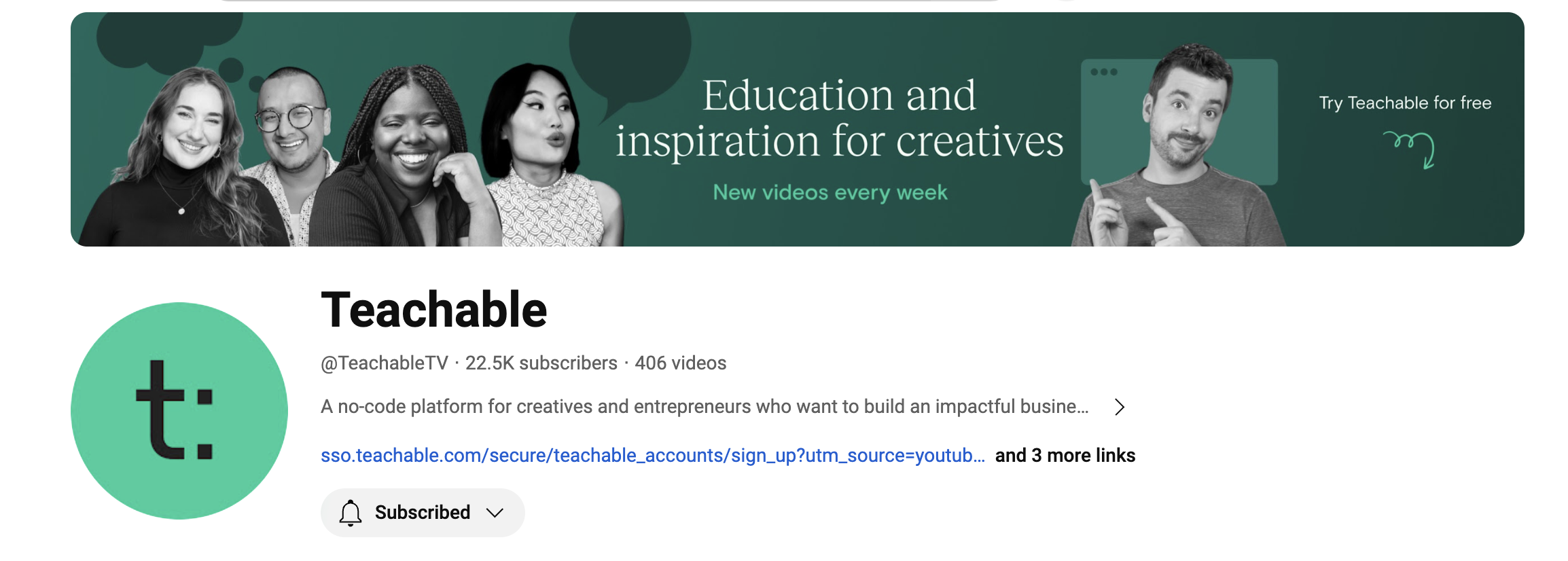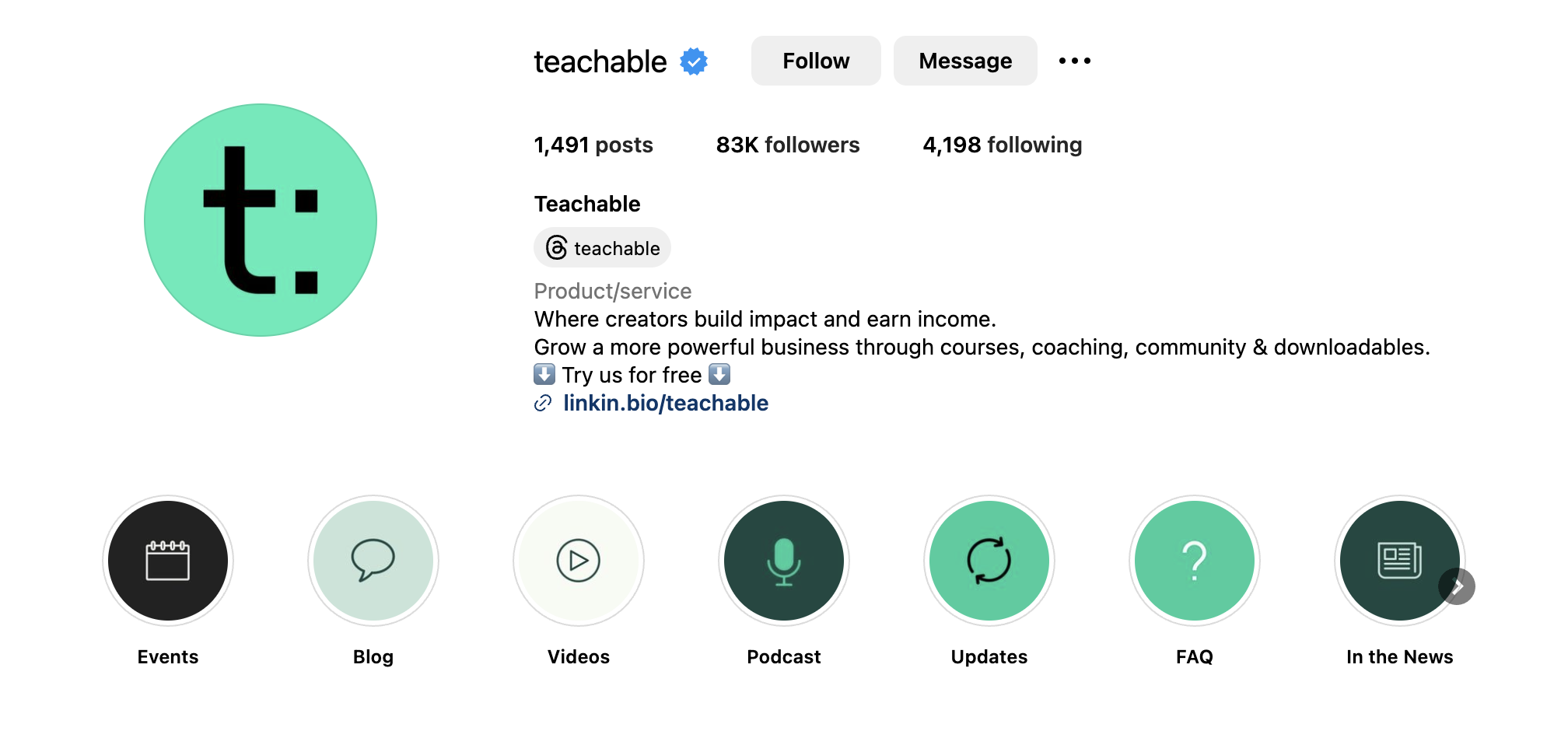For someone who has never worked in sales, marketing your online course and trying to get people to buy can be an intimidating process. Luckily, the first sale is the hardest. Once you’ve gotten over that hurdle, you’ll get into the selling “groove” and you should have an easier time making your next sales. But that brings us back to square one: making that very first sale.
Luckily, there are tried and true methods for selling your online course, and the important part for you is to figure out which ones will work best for you. Here are our favorite ways to make your first online course sale. We’ve ranked them from most successful to least.
In no way do you need to try and execute all of these strategies or even half of them. Choose the one or two that stand out to you and go from there.
In this blog post we’re going to go over:
- The most common and successful ways to make your first sale on Teachable
- Tips on how to get started with each method even if you’re a total beginner
- How exactly to make the first sale using each method
Make your first sale with an email list
If you’ve spent any time here on the Teachable blog, you might be sick of hearing us talk about the power of a targeted and warm email list.
In short, your email list is comprised of people who opted to follow you in exchange for the value you provide. Whether they sign up during a webinar you host, to get a free piece of content, or to get access to your valuable emails, these are your highest converting audience members.
How to grow your email list
People sign up for your email list in exchange for value. The quickest way to entice people to join is by creating a lead magnet. A lead magnet is a free download, worksheet, PDF, report, video, or whatever you choose that is informative and helpful to your audience. It should be valuable enough that your audience will be excited to sign up and glad they did even after they receive the freebie.
At Teachable we recommend that course creators use a free mini course as their lead magnet. It can be very short, but it needs to provide real value. Cassidy from Succulents and Sunshine has a great example of a mini course here.

How to keep your email list warm
One of the most important things your can do to have a high-converting email list is to keep it warm. You can’t expect people to sign up in August and not hear from you again until May and still be interested in your course. In fact, people will likely forget about who you are and what you do by then.
To keep your email list warm, send regular updates and newsletters. Now, you don’t have to be emailing 3x a week, but weekly or bi-weekly emails will keep you on your audience’s radar. Just be sure it’s consistent so your followers know when to expect to hear from you.
Make sure that you’re sending high-quality, targeted content that will help establish you as an authority and someone to turn to in your niche. When you’re deciding when to send your newsletter, consider these factors:
- When is your audience active? Are they stay-at-home moms checking their inboxes at the 3pm pick-up line or are they businesswomen not getting home from work until 6pm?
- When do you usually check your inbox? Nobody will have more in common with your audience than you do, so check your habits. Your audience likely has similar ones.
- When is your audience spending the most time online? Maybe they’re checking their emails at 3pm, but not actually spending any real time online until after their kids sleep at 9pm.
What if my list has gone cold?
Don’t fear, you can re-warm your list and turn it into a conversion machine. The first thing you should do is send an introduction email. Segment out anyone who has signed up in the last month, and send everyone else a re-introduction.
Let them know who you are, what you’ve been up to, and what your greatest resources are—and send them something that’s incredibly high value so that they stick around. From there, send regular emails so they don’t forget you.
How to sell to your email list
Selling to your email list can be a lot of fun if they’re warm, because they’ll be more engaged and excited about what you have to sell. We recommend selling in two different phases. Pre-sales and actual sales.
Pre-sales
Your pre-sale phase will come in a one-two punch.
Day 1 is the course teaser
This is when you tell your subscribers that you’ll have an exciting announcement coming out soon, and that you’ll be opening an online course. This is where you start building anticipation, which will keep readers engaged and coming back for more.
Day 2 covers the course details
In this email, you answer, “What’s in the course?” and you explain in detail what your milestones and lessons are for the entire course. You’ll end by telling them that the course is going to become available tomorrow, but you won’t share the sales page yet.
Sales
On Day 3, you’ll announce that your course is open
This email is your big moment, when you finally get to share that your course is available. You’ll link to your sales page, and you might consider including a few testimonials in your email. You’ll also need to make it clear that this is a limited-time offer.
Day 4 is your FAQ email
Using an FAQ email is the perfect opportunity for you to appeal to your subscribers’ logical side and squash any concerns they might have about your course. Tell them about your 30-day guarantee, and reassure them that they’ll have lifetime access.
Share what the course includes, and see if you can anticipate their questions. You’ll provide the questions and answers right in the body of your email. Again, the CTA for this email will be to click on your sales page link, and you’ll want to reiterate that this offer ends on X date at Y time.
Day 5 is the surprise bonus email
This is a fun opportunity for you to tell you subscribers that you’re giving them a new surprise that you haven’t mentioned on the sales page if they buy now. This should either be bonus content or an even steeper discount.
Day 6 is the thank-you & social proof email
At this point, you want to thank everyone for reading your emails and being part of your launch. Hopefully by now you may have gotten excited emails or social media posts from new customers, so you can include some anonymized screenshots where new customers are raving about your content.
By now you’re nearing the end of your launch, so now Day 7
The day before your launch ends—is the logical argument. You’ll tell everyone that your course will be closing, and you’ll build a logical argument convincing them why they need to buy right now. Remind them about your bonus, and remind them how soon the sales window closes.
Then finally you’ll arrive at Day 8, the final day in your launch
On this last day, you’ll be sending not one but two emails. It seems like a lot, but trust us on this one! It’s worked for our most successful instructors here at Teachable.
The morning email goes out at 11 AM
You’ll announce that today is the absolute last day to get the course, and that sales end at midnight.
Then the afternoon email should go out around 3 or 4 PM
This is their last chance email, when you’ll reiterate that sales close at midnight, and that they won’t want to miss out on this opportunity. Congratulations! Chances are you’ve made your first (and probably second, fifth, and tenth) sale by launching to your email list!
{{threesteps-component="/blog-shortcodes/blog-popup"}}
Make your first sale with a YouTube channel
YouTube is a great platform for making a connection with your audience and really showing off who you are and what you’re capable of. If you can establish a high-quality YouTube channel with engaged followers, converting some of them to your paid course is pretty basic.

Making your first sale on YouTube is as simple as:
- Making high quality content
- Proving you have something to offer
- Selling a product that will solve your audience’s problems
If you think that YouTube is the right platform for you, keep in mind that YouTube favors a few things:
- Regular uploads
- HD quality
- SEO optimized description boxes
If you can accomplish all three, you’ll likely find more success on the platform than someone who is sporadically uploading and not optimizing anything. Now, you don’t need any of those things to be successful on YouTube, but they will certainly help.
How to make your first sale on YouTube
Theoretically, all it takes is for one video to go viral, but you can never count on a video going viral—it’s largely up to chance. So, instead, you will need to go in with a solid strategy. Our recommendation is creating a four-part series warming your audience up to you and your online course.
Step one - establish your expertise
Create a valuable video walking your audience through some aspect of what your online course is going to cover. Don’t worry about giving away bits and pieces of what will be included in your main product, your focus here should be providing value.
For example, if you’re a gardening course creator, you can create a video walking your audience through setting up an indoor gardening space start to finish. Be detailed and clear and prove that you’re an authority when it comes to gardening.
Step two - mention your paid product
This video should also be incredibly high value. Introduce the topic by saying, “Hey, I’ve been working on creating an online course on ________ and I was so excited about ________ that I had to share this section with your right now.
At the end of the video, let your audience know when you expect the course sales page to be live.
Step three - host a Q&A
You can really establish yourself as an authority here by hosting a Q&A. Ask everyone who follows you on social or who is on your email list to submit questions to answer. No shame, if you don’t get questions have your friends and family send you some, or make some up based on what people have come to you for advice on in the past!
It doesn’t matter who is asking so long as you can host a valuable Q&A where you’re able to flex your expertise.
Step four - announce your online course or digital product
Announce your online course! If you’re okay with the clickbait game, title your video something like, “I am so excited…” for the first hour or two to get people curious and clicking, and then change the title to be optimized for SEO after your first wave of views. In this video walk your audience through what your course is, the value it provides, and what people will get from taking it. Be excited and high-energy so that your audience feels excited. Make sure to link to your sales page in the description.
Do this after you post your YouTube video
Go back into your first three videos and add an annotation at the beginning letting everyone know to check your description box for a link to your online course.
In-real-life (IRL) marketing
People love to connect with real people. Anonymous names and pictures on the internet can be stiff and uninviting and they don’t always invite trust. Whether you’re able to speak at a conference or just go to a networking event, making an in person appeal can go a long way.
Giving an impassioned talk about what you have to offer and your history in your niche can resonate with people like you wouldn’t believe. If there is a local conference happening in your niche, reach out to the coordinators to see if there is a need for speakers or panelists.
Again, people are going to feel more connected to you after seeing you in person, and having the opportunity to engage with you in a real way will build trust and make it easier to convert the audience into customers. And even if your local conference doesn’t have an opening for speakers, attending is great for networking.
Hosting in-person events
If you want to take things into your own hands, you could also host an in-person event to people interested in your area of expertise. Hosting a live training for people in your area gives you the opportunity to better connect with your potential customers and gain their trust.
You could do this by turning the first lesson in your online course into an in-person presentation and teaching it where your audience hangs out whether that’s a university, yoga studio, culinary school, or somewhere else entirely.
If you don’t have any local places that totally make sense for your live training, consider reaching out to your local library or co-working space. In my area, our co-working space will actually give anyone who hosts an event a free month membership because they’re so grateful to get people in the building and interested in the space.
How to sell at in-person events
The key here is to really connect with the people you speak with and present a solution to the problems they might be having.
Print out business cards (or DIY some) with a link to your sales page and maybe even a coupon code. If people feel like you provided value at the event, they’re more likely to feel like they can trust your paid product to provide value, too.
Use Twitter (X) to make your first sale
X is interesting because it’s a platform where people are still excited to engage. They don’t want to scroll through boring tweet after boring tweet. They want something funny or clever to retweet or respond to, so consider getting outside your comfort zone.

How to get your first sale on Twitter
The most important thing to keep in mind on Twitter is that you do not want to come across as salesy or pushy. Twitter champions authenticity, so at least 80% of your tweets should be stand alone tweets that aren’t linking to your sales page or people will be less likely to follow.
Build your following and clout on the platform by tweeting real and engaging quips that are relevant to your audience. Whether you’re a food blogger rejoicing in finding the perfect avocado or a tech blogger celebrating your first app in the app store, spend most of your time being you. You can also tweet out other people’s content to build positive relationship and your niche and provide value to your followers.
The other 20% of the time you can self-promote. Once your audience trusts that you provide value, promote the heck out of your content. Don’t just tweet a link to your sales page. Instead attach images or valuable quotes from your course so people don’t just scroll past. You can also incentivize people to retweet or share by offering a coupon in exchange for a retweet.
Also, choose your most enticing promotion tweet and pin it to the top of your profile. Your pinned tweet will be the first thing anyone sees when they go to your profile.
Leverage Instagram to make your first digital sale
Selling on Instagram is great for visual brands or people who already have a following on the platform. Instagram is a bit trickier to sell on compared to other sites because they don’t allow you to link within your posts. But, you can add a link to your bio, and if you have over 10,000 followers you can add a link to your Instagram stories.
Instagram is all about engagement. If you’re not engaging with people, you’re not going to grow and you’re not going to get on anybody’s radar. Make sure to follow others in your niche and people who might be interested in your topic. Spend time going through your feed to like and comment on pictures that catch your attention.
Beyond that, it’s important to post high-quality content. Instagram is a visual platform, so the accounts that are growing the quickest are the ones posting the most beautiful imagery.

Getting your first sale on Instagram
We recommend finding a picture that is somehow related to your course topic and editing a text overlay on top of it. Keep the text simple and clean so it doesn’t make your picture look spammy, and have it say something like “Exciting announcement!”
From there, use the caption to announce your online course and direct people to click the link in your bio. Instagram is tricky because people have a short attention span and will oftentimes just mindlessly scroll. If you don’t have an engaged Instagram audience, this might not be the right method for you.
{{socialmedia-component="/blog-shortcodes/blog-popup"}}
Join more than 150,000 creators who use Teachable to make a real impact and earn a real income.



